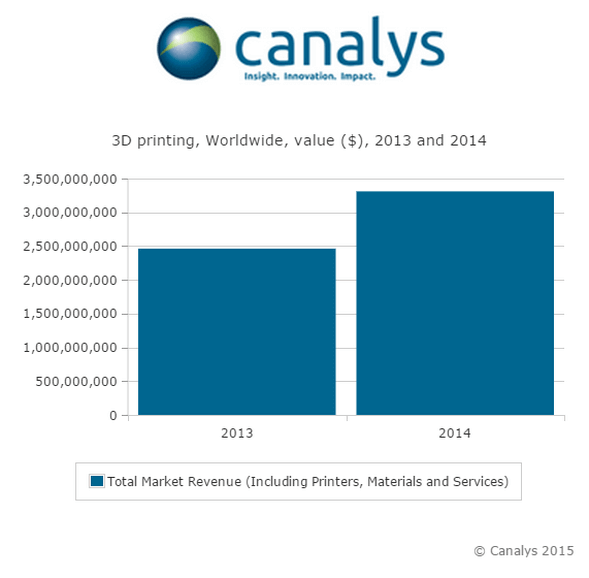TLDR: With the current layoffs at Makerbot and the demise of smaller companies, it may seem an odd timing. But market researchers are very confident that 3D printing will be bigger than the internet.
The 3D printing market just aggregated an estimated revenue of 3.3 billion US-dollars worldwide in 2014. That´s over a third more than in the previous year 2013. Prices for 3D printers are going down, and as the machines get much more affordable, the user base grows. More and more customers buy their first 3D printer, extending the user base and thus improving the support from and for the community.
3D printers: the new go-to holiday gift?

Roughly 133,000 units have been shipped in 2014, claims Market researcher Canalys. This is a 68 percent increase over the year 2013. Together with materials, services et cetera, they make up that incredibly high number. I am just repeating… $3.3 billion.
“We’ve seen the 3D printing industry go from strength to strength in 2014,” said Canalys Research Analyst Joe Kempton. “As we expected, the holiday season saw the most significant growth, particularly in the consumer segment, with many users buying their first 3D printer. A combination of falling prices, a wider range of technologies on offer and improved printing speeds helped fuel this demand.”
The research firm estimated that three-quarter of 3D printers shipped in the last quarter of 2014 was priced below US$ 10,000. In that quarter alone, total market revenue exceeded US-$ 1 billion for the first time in one quarter, with some 41,000 3D printers shipped worldwide. This represented a 24 percent climb over the previous quarter.
Major market players such as MakerBot and Ultimaker experienced significant growth, as well as Chinese vendors such as XYZPrinting, which could significantly increase shipment numbers. Kempton noted that Chinese manufacturer’s success could be explained because they produce ”consumer-friendly 3D printers at impressively low price points”.
“Low-priced consumer and prosumer 3D printing has made leaps in terms of technological ability, including those coming through crowdfunding portals such as Kickstarter,” noted Kempton. “Whereas these consumer printers used to be almost exclusively material extrusion devices, we’ve seen large growth rates in the vat polymerization segment as prices have fallen, which means more options for consumers.”
Want a second opinion? Read interview with 3D printing expert Terry Wohlers
But…b…b-bigger than the internet?

If you’re asking if there could be a technology as important as the internet, I’d certainly say no. In 2012, an estimated of 4.7% of all US economic activity resulted from the internet. But as 3D printing is still rising, the Canalys analysts expect 2015 will produce even more impressive numbers regarding 3D printing. Until we see a limit to the 3D printing industry’s growth, we can not properly compare these two technologies. It may still take some time until 3D printing is as omnipresent as the internet. In times of the first computers, nobody could imagine more than 5 of them being built worldwide – far less what their impact on humanity might be.
When the internet – the universal, worldwide network – emerged, computers were slowly getting in more and more households. Nobody would have thought “This internet thing, it is going to rise just like home computers!”. Now there are computers on our wrists and in our cars, in practically every appliance we own. And in the future, it is said, they will form the “internet of things”. Sounds exaggerated if you think of it, does it?
Of course, we could just overhype 3D printing, but in a few years we will have more numbers that will be our proof or falsification.
Steve Sammartino, a digital entrepreneur, business adviser and venture capitalist estimates the potential of 3D printing reaching as high as that of the internet. In fact, in an article published by ABC News in Australia, Sammartino made the prediction that 3D printing will have an even larger economic impact than the internet had. Sammartino explained:
“It’s just a little bit like the internet. When it arrived we thought, ‘Oh, that may be interesting for media’, but as we’ve seen it’s transformed every type of business no matter what industry. The internet is an important part of our business, and 3D printing, while we can’t see exactly how that might manifest itself, there’s no doubt that it’ll change everything we do from just simple operations and the spaces we work in and in unforeseeable ways it’ll impact, I think, most businesses.”
Some numbers…
In the United States, the manufacturing sector generates somewhere around 2 trillion dollars each year. On a global scale, roundabout 11.5 trillion dollars (sic) are generated. If 3D printing becomes a part in all of manufacturing, this is a big number. But game changer 3D printing will not only affect the manufacturing sector in the future. The 3D printing industry is in an exponential growth. While traditional businesses may try to hinder the development in all the ways they can, we can’t see where it will end – yet.
In ten years, we´ll know if Sammartinos claims are a bold statement or insightful vision.
License: The text of "3D printing may have a larger impact than the internet" by All3DP is licensed under a Creative Commons Attribution 4.0 International License.